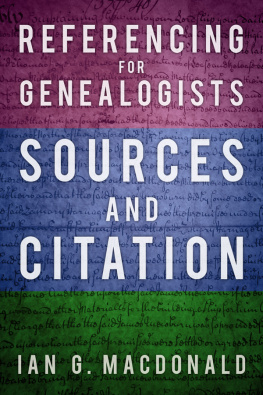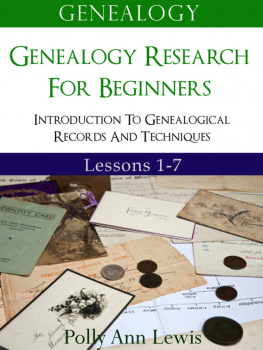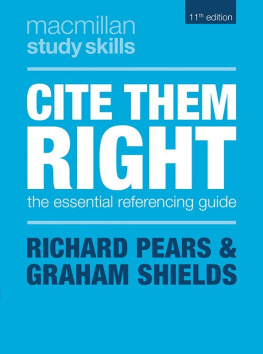Contents
Guide
First published 2018
The History Press
The Mill, Brimscombe Port
Stroud, Gloucestershire, GL5 2QG
www.thehistorypress.co.uk
Ian G. Macdonald, 2018
The right of Ian G. Macdonald to be identified as the Author of this work has been asserted in accordance with the Copyright, Designs and Patents Act 1988.
All rights reserved. No part of this book may be reprinted or reproduced or utilised in any form or by any electronic, mechanical or other means, now known or hereafter invented, including photocopying and recording, or in any information storage or retrieval system, without the permission in writing from the Publishers.
British Library Cataloguing in Publication Data.
A catalogue record for this book is available from the British Library.
ISBN 978 0 7509 8840 7
Typesetting and origination by The History Press
Printed and bound by CPI Group (UK) Ltd
eBook converted by Geethik Technologies
Contents
Foreword
Genealogy is little more than anecdote when the sources for facts are not cited and where clear references to sources are not given. That may be a harsh judgement, but in a world awash with poor genealogy it is a call for raising standards.
This book is about making your work better, more credible, more useful and easier to communicate to all those who may be interested in it, and in what you have achieved and wish to say.
Referencing may seem a bit daunting at first but, like so many things, it is straightforward once you get used to it. The book concentrates on general principles and offers many examples to illuminate what is going on. As a bonus, there are many sources cited in the examples that are valuable to every genealogical researcher, and some may take your investigations off on new paths.
The Strathclyde experience
This book has its origins in, and takes its inspiration from, things initiated not so long ago in Scotland that, themselves, are part of a continuing effort to raise standards in genealogical practice.
The University of Strathclyde launched its first courses in postgraduate-level genealogical studies in 2005. These were taught on campus in Glasgow and made available online. A switch to complete online delivery and tuition soon followed. The initial offering of a postgraduate certificate was immediately followed by a postgraduate diploma and soon could be followed by a year of supervised research leading to the degree of Master of Science in genealogical studies the first of its kind in the world.
The first students graduated with their diplomas in 2008 and with MSc degrees in 2010. The emergence of these qualified genealogists marked a step change in genealogical practice, not just in the UK but around the world in the many other countries where Strathclydes online students are based.
The background to this work
From the outset, Strathclyde courses insisted on a high quality of delivery from students that would build on the prior experience they all possessed. So, as part of the disciplined, systematic approach demanded of them in their investigative work they were expected to provide clear identification of all sources used in reaching their genealogical conclusions.
Guidance was provided to them in how to cite these sources and on how to format references. That guidance has been improved and enhanced over the years to make it ever more suited to good genealogical practice. Until now the material has been available only to students, but there has been a growing recognition that it could be of value to a wider audience.
For that wider audience, the guidance and explanation has been expanded much further to create this small book in the hope that it will be of service to the genealogical community.
The book does view sources and referencing from a UK perspective. However, it assumes that immigration and emigration, and families scattered worldwide, are an integral part of that perspective. Sources from many parts of the world, from wherever a family has spread to, must therefore be used and cited in support of genealogical conclusions. A consistently clear way of referring to these sources is thus essential to enable good communication among practitioners. The approach in this book is sufficiently general to be valuable to anyone from outside the UK, particularly those with a link to the UK. That being said, the books focus is also primarily on sources from the English-speaking world.
Contributors and collaborators
Ian Macdonald has prepared this book for publication. However, it has its origins in material prepared by Bruce Durie and Graham Holton, the initiators of the Strathclyde courses, and has been enhanced greatly over subsequent years by Tahitia McCabe and other members of the Strathclyde tutor team.
Some examples have been gleaned from the work of students. These citations have not themselves been cited that all felt too incestuous and, in any case, they have mostly been adapted. Lessons too have been learned by observing students struggle with some formats so, if this book makes things seem more straightforward, then thanks must be offered to all.
Other support has been given by members of the Register of Qualified Genealogists (www.qualifiedgenealogists.org), an exceptional group of professionals.
Various examples relate to Mewburns, a family that simply happens to have been studied in detail. More on them can be found at www.mewburn.one-name.net.
Some wording remains from the Strathclyde guidelines along with occasional examples. I am grateful to the University of Strathclyde for permission to incorporate these elements.
1
Introduction
Quality in genealogical investigation: why does all this matter?
Findings need to be communicable. We take this to be a fundamental principle. If findings cannot be shared they have no value. This book is not for the genealogical hermit whose work is to follow them to the grave.
Genealogists gather data relating to people who lived in the past and they use that data to infer things about those peoples lives and, most importantly, to infer familial linkages between them. Notions of ancestry or descent are developed. Whether or not these notions are correct and the linkages are accurately made are central to good genealogy by which we mean reliable genealogy. Reliable genealogy is genealogy that can be replicated. The quality of the work is assured when others can reach the same point, and come to the same conclusions, by using the same information sources.
Reliable conclusions depend on reliable data. The old GIGO acronym garbage in garbage out beloved of practitioners in information technology, applies equally to genealogy. We need to be able to convince others that the data is reliable and that there is therefore a sound basis for conclusions. Good genealogy revolves around ways of establishing how good the data is. It proceeds in steps, where logic is applied to the discovered data to determine causal linkages. If the data is at any point unreliable, the logic fails and can produce false or misleading conclusions.
Central to any good investigation is, therefore, an appreciation of where the data came from the source because, by knowing where it came from, any other investigator can re-examine it and re-establish conclusions reached by others. Equally importantly, they may be able to re-interpret those conclusions by introducing newly found material. By providing references to sources, so indicating where the information can be found, a transparency is added to any investigation. That transparency offers an assurance of quality because all assertions made can always be checked.







